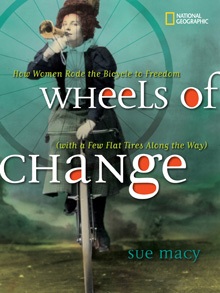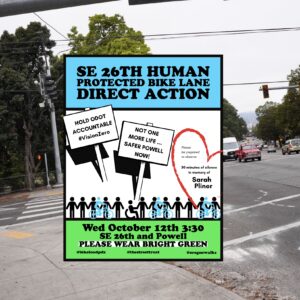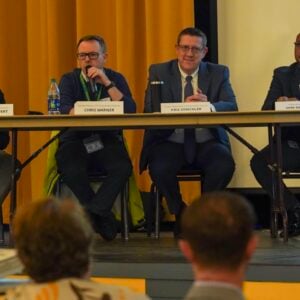
(Photo © J. Maus/BikePortland)
The gender gap in bicycling will get its first national stage when the 2012 National Bike Summit begins in Washington DC next month. The Alliance of Walking and Biking and the Association for Pedestrian and Bicycle Professionals have announced the inaugural National Women Cycling Forum, a free event to raise awareness of the gap and figure out how to close it.
The event will be held on March 20th, in conjunction with the summit. Keynote speaker will Sue Macy, author of Wheels of Change: How Women Rode the Bicycle to Freedom (With a Few Flat Tires Along the Way) (2011, National Geographic Childrens Books).

Here’s more from an event press release:
Women still cycle at much lower rates than men in the United States — making up just 24 percent of bike trips in 2009. But that trend is shifting. This Forum will be the first national gathering specifically dedicated to raising awareness about and discussing how to engage more women in bicycling.
“This critical topic and rising energy is gathering momentum across the country as more women of all backgrounds are starting to ride or getting more involved in the movement,” said Carolyn Szczepanski, Communications Coordinator for the Alliance for Biking & Walking. “We’re eager to start a continuing conversation aimed at increasing the number of women who bicycle for transportation and recreation.”
In addition to Sue Macy, other confirmed speakers include: Elysa Walk, General Manager, Giant Bicycles Inc.; Marla Streb, former World Mountain Bike Champion; Andrea Garland, Planner, Alta Planning + Design; Veronica Davis, Founder, Black Women Bike D.C.; Kimberly White, Youth Advocate, Recycle-A-Bicycle; Nelle Pierson, Events Coordinator, Washington Area Bicyclist Association.
On Wednesday evening following the event (3/21), there’s also a Women Cycling Social planned.
Stay tuned for coverage of these events. I’ll be at the Summit this year (thanks in large part to the generous support of Planet Bike!), and will share stories and photos from D.C. The National Bike Summit is March 20th – 22nd.






Thanks for reading.
BikePortland has served this community with independent community journalism since 2005. We rely on subscriptions from readers like you to survive. Your financial support is vital in keeping this valuable resource alive and well.
Please subscribe today to strengthen and expand our work.
It’s back! My fave J.M. photo of 2011!
“why don’t we see more of this?”
Because most women are smart enough to wear helmets.
PLEEEEEEEEEEEA
PLEEEEEEEEEEEEEEEEEEEEAAAAAAAAAAAAAASSSSSSSSSSSSSSSSSSSSSSEEEEEEEEEEEEEEEEEEE!!!!!!!!!!
PPPPPPPPPPPPPPPPPPPPPLLLLLLLLLLLLLLLLLLLEEEEEEEEEEEEEEEEAAAAAAAAAAAAAAAAAAASSSSSSSSSSSSSSSSEEEEEEEEEEEEEEEEEEEEEEEEEEEEEEEEEEEEEEEEEE!!!!!!!!!!!!!!!!!!!!!!!!!!!!!!!!!!!!!!!!!!!!!!!!!!!!!!!!!!!!!!!!!!!!!!!!!!!!!!!!!!!!!!!!!!!!!!!!!!!!!!!!!!!!!!!!!!!!!!!!!!!!!!!!!!!!!!!!!!!!!!!!!!!!!!!!
The lack of a helmet was the first thing I noticed too, but my response to “why don’t we see more of this?” was “uh, we see way too much of this.”
there have been far too many senseless and brutish killings of pedestrians by motorists in pdx. fortunately, there have been no cyclist deaths in PDX for several years. it seems to me that we have more important safety problems to address than a young woman cycling without a helmet.
Dustin Finney?
i missed that. very sad,
Really? I see tons of women every day walking around and driving without helmets.
Cars have seat belts and airbags. Pedestrians have protected space and travel 3 mph. You have a non sequitur.
Hmm … walking and driving have far lower rates of head injury than cycling in American traffic. I’m sure that’s just coincidence, though.
We should find some statistics that bear this out. Ken Kifer has this to say about that:
http://www.kenkifer.com/bikepages/health/risks.htm
I meant to pull out at least one bite-sized statistic from that lengthy piece. Here’s one:
“pedestrians have more fatalities per mile of travel than cyclists. (The Environmental Benefits of Cycling and Walking estimates 21 to 44 billion miles of walking and 6 to 21 billion miles of cycling.)”
(link in original is dead)
I realize that fatalities is not the same thing as head injuries which is what you’re talking about, but this may be a start. I suspect there are more recent and perhaps even better statistics out there. This is jut what I found in a quick search.
This writeup by Ken Kifer is just too much fun not to quote. Here’s another paragraph:
“First, automobiles cause almost all the injuries. Over 90% of cycling fatalities are caused by the cyclists being struck by motor vehicles; on the other hand, there are no motor vehicle operators killed by bicycles. When we look at pedestrian deaths, we find that 5,600 pedestrians are struck and killed each year in the United States by motor vehicles and occasionally one or two by bicycles. This indicates that motor vehicles are dangerous, not bicycles. While it’s true that bicycles are not used as much as motor vehicles in this country, statistics from counties where bicycles are used heavily also support the comparative innocence of bicycles in causing traffic deaths. This distinction is not just quibbling; removing all cyclists from the roads would reduce the death rate by less than 2%; removing all motor vehicles from the road would reduce the death rate by more than 95%. The real safety problem is the motor vehicle, not the bicycle.”
Please change your post name to Buzz Killington as soon as possible.
We don’t see more of this because the United States is obsessed with gear to the point of absurdity. Helmets are a joke, and only serve to make cycling something that isn’t normal to most people.
I’m against mandatory helmet laws, but helmets aren’t jokes. I’m smashed two – once when I got hit by a minivan when I was 12 and once going off a jump on a mountain bike. Both times I was very glad I had one. You don’t want to wear one fine. You think I’m a joke for wearing one. Fine, but at least now you know why I do.
For the last time, a broken helmet does not prove the helmet did anything other than break.
You also don’t see it because there is only one bike firm in the US that actually has skirt guards on their bike… Mind you not all, just the Dutch models. … Because girls in the US are feed a media diet of plastic role models that do not sweat and have always perfect hair, manicured nails etc. Because there are no helmets out there that fit well when you have long/thick/braided hair. Because while bike firms do tons of research on their road bike buyer, they don’t do any on women’s bike (wait, they have to be pink!?). Because there is no good rain gear for larger women… Because I would love to throddle bike firm executives, because they are overlooking/neglecting an entire market segment (end of rant)…
Well, to be fair, the skirt guard issue could be resolved with shorter skirts.
The biggest beef I have with bikes is lack of chainguards. Good call here!
Totally agree on the rain gear for us big girls. I bought a rain cape/poncho sort of thing, and it breathes like plastic wrap. I’d rather get rained on than wear something that makes me sweat and sticks to my arms.
There’s also a lot of validity to the comments about social expectation for looks. No way would I ride a bike in a skirt and heels (though I’ve seen plenty of women in Europe do it).
Not that I live up to those expectation to begin with, but a lot of women try to.
“Why don’t we see more of this?”
Wrong time of year in Oregon.
What is the male/female split in terms of bike riding in Portland? I should think it is quite a bit better than the 3:1 statistic from 2009 above, but perhaps not?
When I saw that photo quote, my first thought was, why don’t we see more people riding in cute, everyday clothes, sans-spandex.
A girl on a bike is not that abnormal here in Portland. As for other parts of the country however…
How about more cute girls out there riding in Spandex?
This is a great idea. We need to start having more forums locally to try to get more women and for that matter other low-use communities to increase bike ridership. Obviously Portland is like bike capital, a lot of women already ride their bike, here in Eugene it is much the same, but nonetheless, were are still trying to attract certain demographics (those women or low-use communities that don’t ride) to see bicycling as an actual mode of transportation.
The holy grail of women riding are girls from 12-18… in college women tent to start to ride again. I have a friend who is a bike advocate par excellence who can not get his high-school daughter on a bike.
I was thinking of donating a free prom dress to every girl who rides a bike for 3 month before her prom…
I heard about the inclusion of a Women’s Forum too late for me to be able to raise the funds to make it to DC this year. Does anyone know of a good place to follow the Forum? Twitter user or #hashtag I can follow? I would really appreciate being pointed in the right direction.
Thank you,
Low, mpls
The article wants to ask, why don’t we see more women riding? But the choice of photo asks, why don’t we see more pretty girls with flowy hair and backless tops riding around in short skirts? Not exactly the same question. Part of the answer to both is that most of us can’t get where we’re going without at least a little time on a Sandy or a Barbur or some other nasty road that makes the skin, among other things, feel a little too exposed and vulnerable for the fantasy.
I think you are reading a little too much into the choice of photo. If I recall correctly, I have read BikePortland quoting research that one substantial reason many women don’t ride is because they feel it is incompatible with wearing what they consider to be fashionable attire. I have read Jonathan himself argue that fashion and cycling can peacefully coexist and I believe he chose this photo for that reason.
Perhaps, but I have also been wondering whether the discussion would have been different had Jonathon chosen a different lead photo, only I felt that–as a male–it might be presumptive of me to mention it. Out of 31 (now 32) posts, only three to five (unsure on some nicks) are by women, and I know there are a lot more female BikePortland posters than that. Framing of the question differently, including visually, might elicit more topical response.
Hi everyone,
I’m surprised by all the focus on that image. To me it’s just a woman on a bike.
I’m usually very thoughtful/careful about how images I choose might impact the discussion. In this case I honestly did not think folks would get so fixated on the image itself. Lesson learned I suppose.
You do like to post photos of the girlygirls, Johnathan. just sayin’. peace.
give me a break sorebore.
To bring the discussion back to women and cycling, I think it is great that people are finally taking action to encourage more women to ride. While we have seen an increase in the number of women riding in Portland I would say that the percentage of women to men riding has not increased signifcantly. Eight years ago the City started a Women on Bikes program to do just that – get more women riding. About 1000 women have attended the rides and clinics. What I hear from them is that they want more support – more inviting bike shop staff, more riding groups for their levels, more education on bike maintenance, and safer riding on the street. I know Portland has a lot going on in the bike scene, but most of these women are not connected to that scene. How do we make bicycling more mainstream?
Wish I could go to the conference.
Re: helmets. I won’t go into whether or not they’re effective; I’ve read through the archives on this site and you all have your various opinions.
I’m a middle aged man with a greying mane. I usually keep it tied in a ponytail to keep it under control and out of my eyes. This interferes with the back part of most helmet suspension systems and makes wearing one very awkward and uncomfortable. I could, I suppose, untie my hair, put on the helmet and then tie it up again when my ride was over. It’s not worth it. I don’t wear a helmet anymore. For what it’s worth, I’ve had very few crashes and none involved other vehicles. They all involved loss of skin. I’m very good at tuck and roll, and have never come close to hitting my head. My most important riding safety gear now is a stout pair of leather work gloves, with or without fingers; a hint I got from an urban motorcycle rider in the early ’70’s.